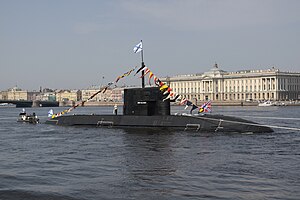
| |
| Class overview | |
|---|---|
| Name: | Lada-class submarine |
| Builders: | Admiralty Shipyard, Saint Petersburg |
| Operators: |
|
| Preceded by: | Kilo-class submarine |
| Built: | 1997–2011 |
| In service: | 1 |
| Building: | 2 (suspended) |
| Planned: | 8 |
| Completed: | 1 |
| Active: | 1 (test boat) |
| General characteristics | |
| Type: | Submarine |
| Displacement: | 2,700 long tons (2,700 t) submerged; 1,765 t Surfaced |
| Length: | 72 m (236 ft 3 in); 67 m on waterline |
| Beam: | 7.1 m (23 ft 4 in) |
| Draft: | 6.5 m (21 ft 4 in) |
| Propulsion: |
Electric propulsion motor on permanent magnets Storage battery with increased service life 2 diesel Air Independent Propulsion (AIP) systems based on oxygen-hydrogen fuel cells 1 shaft 2,700 hp (2,013 kW) |
| Speed: | 21 knots (24 mph; 39 km/h)submerged; 10kt surfaced |
| Endurance: | 45 days |
| Test depth: | 300 m (984 ft) |
| Complement: | 34(38) officers and men |
| Armament: |
6 × 533 mm (21 in) torpedo tubes 18 torpedoes SSM • RPK-6/SS-N-16 Vodopad/Stallion [1]; |
The Russian Navy's Project 677 Lada-class submarine (Russian: Лада) is a class designed by the Russian Rubin Design Bureau. The class is also referred to as the Petersburg (or Sankt Peterburg or Peterburg) class, after the lead ship. A program to develop a "fourth generation" diesel-electric submarine, it aimed to produce a highly improved version of the Project 636 Kilo class with much quieter, new combat systems, and possibly air-independent propulsion.
History
The lead ship of the class, named the Sankt Peterburg, was launched in October 2004 and began sea trials in November 2005. The submarine was transferred to the Russian Navy in April 2010.[1] Another two vessels are under construction at the Admiralty Shipyard with plans to launch four to six submarines by 2015. The Russian Navy has set out a requirement for a total of eight Lada class submarines.[2]
In November, 2011 the Russian Navy has decided that this class of submarines will not be accepted into service, as the lead ship has fallen far short of requirements during tests.[3] The lead boat will be retained as a test vessel to experiment with various systems, the construction of the remaining boats of the class will be frozen.
On July 27, 2012, the Russian Navy commander-in-chief announced that construction of the Lada class submarines will resume, having undergone design changes.[4]
Characteristics

Schematic drawing of the Lada class.
The project 677 Lada is a Russian diesel-electric submarine developed in the late 1990s.
The submarine is designed for ASW and anti-surface warfare, defense of naval bases, seashore and sea lanes, as well as for conducting reconnaissance. The class marks the first usage of the Russian navy of a mono-hull design since the 1940s.
Displacement is 25% lower than that of its predecessor, the Kilo-class submarine. Top speed submerged is 21 knots, up from 19 for the Kilo class. She is designed for an endurance of 45 days with a complement of 34.
The submarine is equipped with automated combat control system Litiy, (eng. Lithium).
A model, designated as the project 1650 Amur is offered as an export model.
Vessels
- Laid down on December 26, 1997, Launched October 28, 2004. Delivered to Russian Navy on 24 April 2010 and commissioned on 8 May 2010[5]
Conducted sea trials in 2010-2011, propulsion and sensors deemed unsatisfactory.
- Kronshtadt (B-586)
- Laid down on July 28, 2005 at the Admiralty Shipyards, will be assigned to Baltic fleet. Construction to be resumed in 2012.[6]
- Sevastopol (B-587)
- Laid down on 10 November 2006 at the Admiralty Shipyards, will be assigned to Black Sea fleet.[7] Construction to be resumed in 2012.[8]
References
- ↑ Армс-Тасс. "Армс-Тасс" (in ru). Arms-tass.su. http://arms-tass.su/?page=article&aid=83525&cid=44. Retrieved 2011-11-22.
- ↑ 11.06.2009. "Russia's Lada sub trials to be completed in 2009". Rusnavy.com. http://rusnavy.com/news/navy/index.php?ELEMENT_ID=7135. Retrieved 2011-11-22.
- ↑ "ВМФ отказался от новейших подлодок проекта "Лада"". Izvestia. 2011-11-23. http://izvestia.ru/news/507580.
- ↑ http://en.rian.ru/mlitary_news/20120727/174805860.html
- ↑ http://ria.ru/defense_safety/20100508/232060077.html
- ↑ http://en.rian.ru/mlitary_news/20120727/174805860.html
- ↑ "Подлодка "Севастополь"". Gazeta.sebastopol.ua. http://gazeta.sebastopol.ua/2006/11/10/pl-sevastopol/. Retrieved 2011-11-22.
- ↑ http://en.rian.ru/mlitary_news/20120727/174805860.html
External links
| Wikimedia Commons has media related to Lada class submarine. |
- http://www.ckb-rubin.ru
- Project-677 class submarine set for final sea trials
- http://www.globalsecurity.org/military/world/russia/677.htm
- http://www.fas.org/man/dod-101/sys/ship/row/rus/677.htm
- Завершаются ходовые испытания подводной лодки "Санкт-Петербург" 24 января 2007 Russian version of he above translation
- [2]
| ||||||||
| ||||||||||||||||||||||||||
The original article can be found at Lada-class submarine and the edit history here.